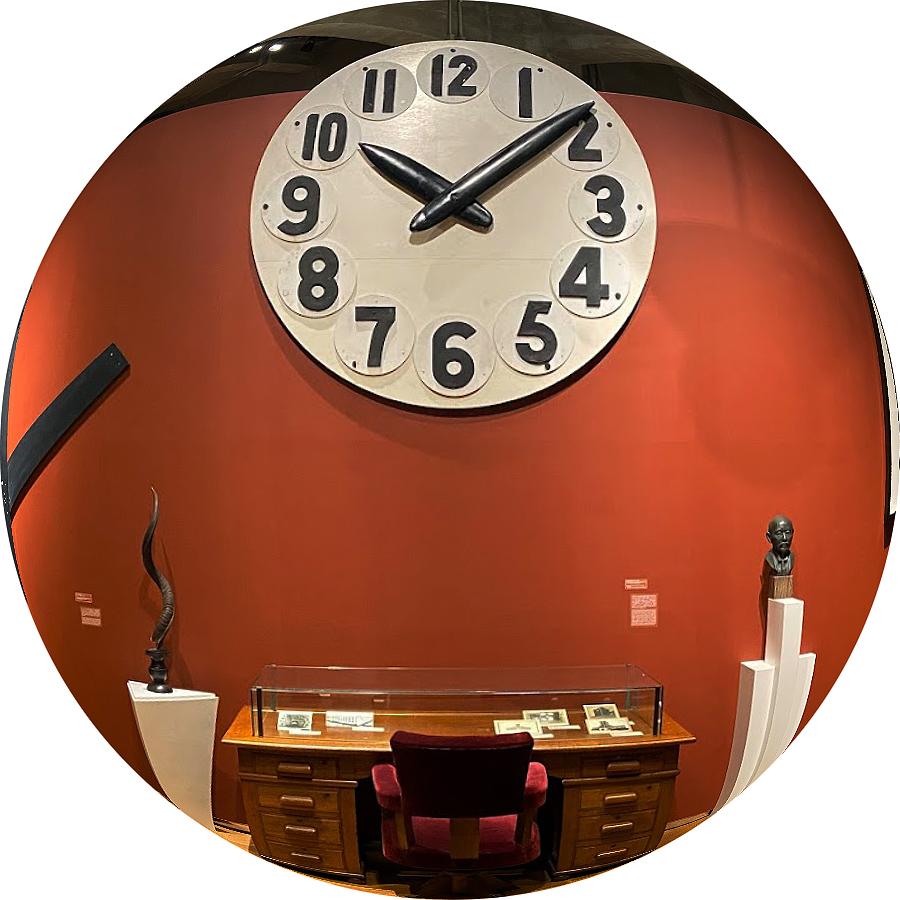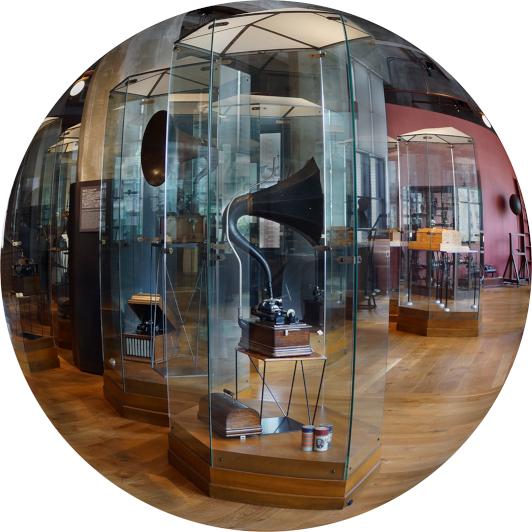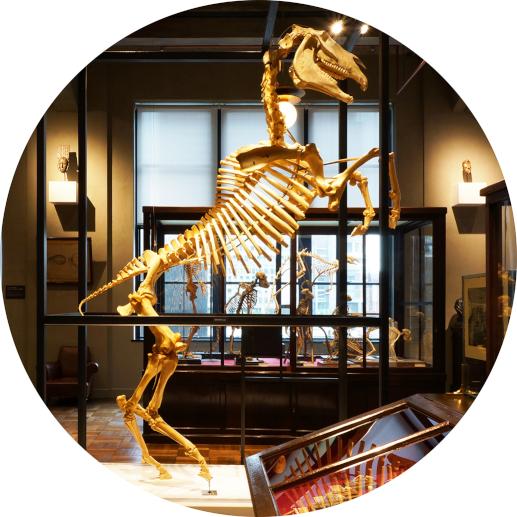Permanent Exhibition "Made in UMUT – The University of Tokyo Collection"
2023.06.27-
COLONNADE 2 COLONNADE 3
Since its foundation in 1877, the University of Tokyo has accumulated a considerable scientific and cultural heritage. Such historical specimens are most certainly an important heritage from the past. However, at the same time, they constitute a resource which we should activate now while facing the future. In order to demonstrate this, we have collected as much historical heritage as possible, and modified its design for a new use, in accordance with our contemporary needs, in the name of a process called ReDESIGN+. Just as the Intermediatheque is built on the reincarnation and inheritance of the former Central Post Office, we have renovated this ancient building and given it a new life as a museum. Nevertheless, this does not imply that we have to consider ReDESIGN+ as a bare revamp activity. In the same way as the etymological meaning of the word design, ReDESIGN+ deals with the problem of appearance at the same time as it raises epistemological issues on our view of things and our view of the world. As for the spatial distribution of the exhibits, we deliberately avoided the common method of setting up a visiting route. What the Intermediatheque aims at is providing a museum space where visitors, and especially younger generations, can experience a direct visual contact with exhibits, in an encounter full of discoveries and astonishment.
Considering the fact that the architecture of the former Post Office building is representative of early Showa modernism, the permanent and semi-permanent exhibition spaces were designed so as to produce a retromodern atmosphere. Respecting the building’s original design, we have adopted an eclectic design principle stimulating our 21st-Century sensitivity, tentatively named retrofuturism. We thus intend to present to our visitors a period bridging three centuries, from the 19th to the 21st Century. Such is the base of our design strategy for the Intermediatheque. With such a scheme in mind, we have actively redesigned and reused the prewar wooden furniture that was accumulated in our museum. On the other hand, a modern sensitivity is created through the use of showcases made of thick green glass and designed in a retromodern style. These are a fruit of the research conducted in product design at the Intermediatheque.
The above is the concept of the permanent exhibition at the Intermediatheque, stated by Yoshiaki Nishino, the first director, in 2013. Its basic philosophy ReDESIGN+ and the key tone retrofuturism will be retained for the exhibition renewed in 2023, as we believe their significance will intensify. The privileged academic history of the University of Tokyo, the oldest university in Japan, has naturally increased with time. The value of the former Central Post Office building as a cultural heritage site that accommodates the Intermediatheque has also increased. Simultaneously, changes in our societies today have become increasingly prominent. In other words, the significance of the mission that bridges the gap between them by means of ReDESIGN+ and challenges to create retrofuturism has been on the rise.
In 2023, on the 10th anniversary of the Intermediatheque, we alter the permanent exhibition while maintaining the concept. First, we have achieved a rough division of the exhibits: natural history on the second floor and cultural history on the third floor. In addition, some of the exhibits displayed on old bookshelves, which were difficult to see in detail, were moved to flat cases for the convenience of visitors. I dare to say that the division is rough because a strict distinction between natural and cultural history is insignificant for creating the space of wonder that every museum must offer. Second, we allowed visitors to photograph most of the permanent exhibition spaces and the exhibited specimens. Since its opening, the Intermediatheque has prohibited visitors from taking photographs to provide them with an opportunity to see and experience things directly with their own eyes. There is no sway in the policy of maintaining the appeal of onsite experience. Our intention of this change is directed to further develop the means for experiencing the Intermediatheque in the digital transformation era.
Despite these changes, scientific specimens collected by the University Museum at the University of Tokyo remain at the core of the permanent exhibition. Since its founding in 1877, the University of Tokyo has had multiple museums, called museum rooms, for educational purposes. They constitute a prototype for today’s university museums in Japan. Unfortunately, these early facilities lost their function a century ago because of renovations and the Great Kantō Earthquake. However, many specimens have survived to date. The Intermediatheque redesigns and displays them on the original display boards, together with comparable old fixtures, old photographs of the exhibition rooms, and related specimens, aiming to develop the archeology of science.
In addition to the legacy since the foundation of the university, many specimens that have been collected and/or manufactured since 1996, when the University Museum was reorganized, also constitute the permanent exhibition. Large skeletal specimens of minke whales, giraffes, false killer whales, red deer, and Hokkaido draft horses are newly created specimens. Exhibits duplicated from overseas collections, deemed of high educational value, include the skeleton of the extinct bird Aepyornis.
Specimens on display also include donated items. The largest group is a collection brought by the bereaved family of a late faculty member. The examples include a collection of four generations of the Miyake family, centered on medical instruments and documents owned by Hiizu Miyake, who was a professor of medicine during the 19th century, and a collection of engineering-related materials from the Meiji to early Shōwa eras spanning three generations, notably Fuji Tanaka, who was a professor of engineering. The collections of cultural history formerly owned by professors during the Shōwa era, such as Namio Egami and Takeo Naka, also belong to this category.
In contrast, there are also exhibits that have been donated or entrusted based on the development of off-campus networks. The Yamashina Institute for Ornithology has exhibited stuffed bird specimens (many of which belonged to Emperor Shōwa), the bird and animal specimens formerly owned by the Oita Wild Bird Museum in Gifu, and the Machikane crocodile fossil reproduction formerly owned by the Amami Harano Agricultural Museum. In addition, the exhibition includes New World craft specimens entrusted by the BIZEN Museum of Latin American Art in Okayama. A large collection of gramophones or a modern industrial heritage donated by private individuals also enrich the permanent exhibition. A unique gift from overseas are the display cases that housed Asian arts collected by Emile Guimet in the 19th century, France. They are now used to display the University of Tokyo’s scientific specimens at the Intermediatheque.
I have only referred to historical specimens so far. However, it is not surprising that the results of advanced research at the University of Tokyo are also brought to the exhibition: a 4.4-million-year-old Ramidus hominin fossil tooth that rewrote the history of human evolution, meticulous replications of medieval and early modern Buddhist statues based on precise experimental research, and an engineering robot that faithfully reproduces the movements of living animals, including humans. If visitors look around the permanent exhibition, they will certainly be able to comprehend the endless advancement of science and education.
In short, the Intermediatheque is an urban annex exhibiting the activities of the University Museum at the University of Tokyo. In the permanent exhibition, the achievements of the curiosity-driven researchers at the university are ReDESIGN+ under the name of retrofuturism and displayed on the Shōwa modern building floor in the central business district of Marunouchi.
Yoshihiro Nishiaki
Director, Intermediatheque
2023



